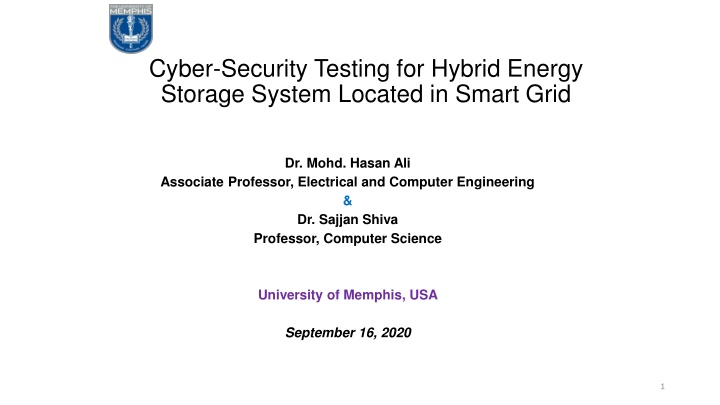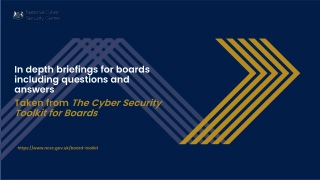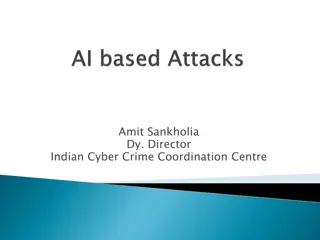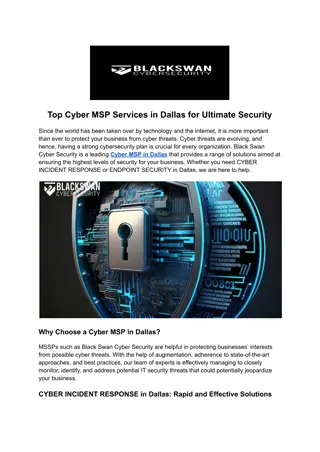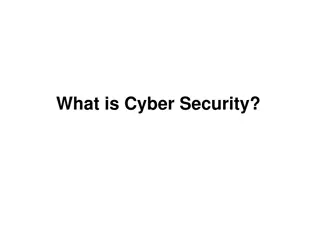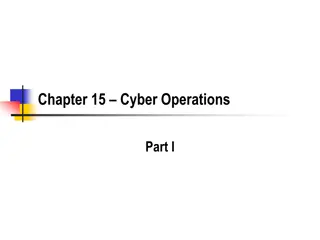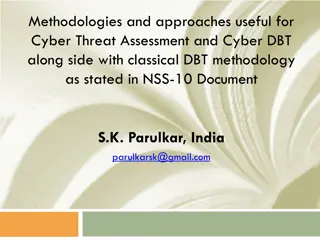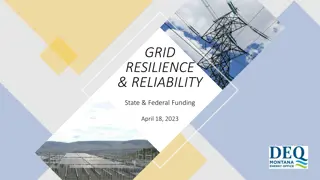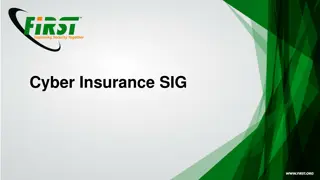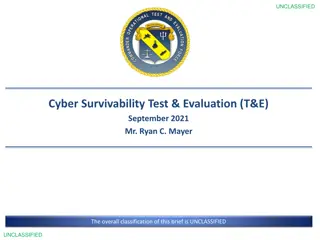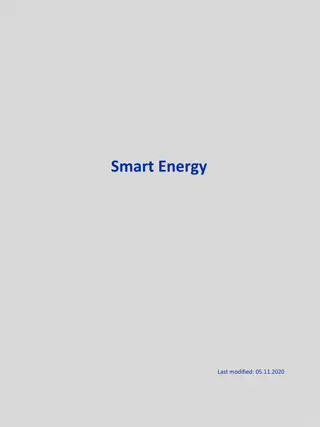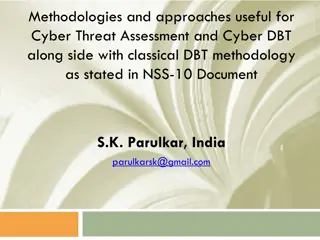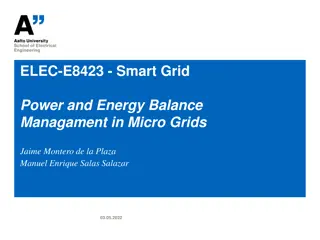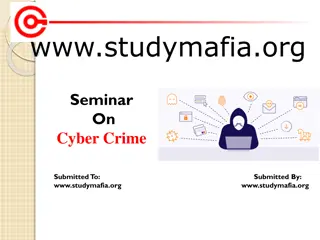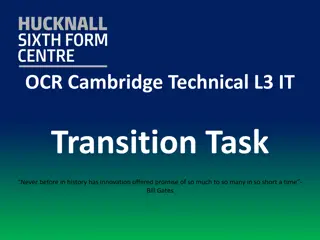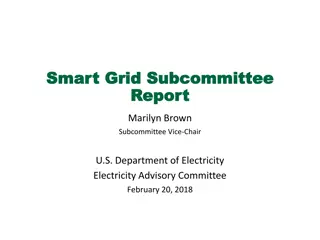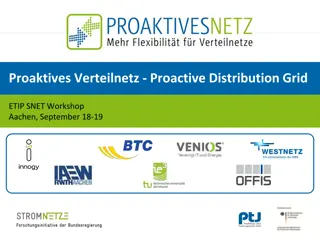Cyber-Security Testing for Hybrid Energy Storage System in Smart Grid
Examination of cyber-security issues in hybrid energy storage systems within smart grids to enhance resilience and reliability. Analysis of cyber-attack impacts, testing methods, and integration of renewable energy sources.
Download Presentation

Please find below an Image/Link to download the presentation.
The content on the website is provided AS IS for your information and personal use only. It may not be sold, licensed, or shared on other websites without obtaining consent from the author.If you encounter any issues during the download, it is possible that the publisher has removed the file from their server.
You are allowed to download the files provided on this website for personal or commercial use, subject to the condition that they are used lawfully. All files are the property of their respective owners.
The content on the website is provided AS IS for your information and personal use only. It may not be sold, licensed, or shared on other websites without obtaining consent from the author.
E N D
Presentation Transcript
Cyber-Security Testing for Hybrid Energy Storage System Located in Smart Grid Dr. Mohd. Hasan Ali Associate Professor, Electrical and Computer Engineering & Dr. Sajjan Shiva Professor, Computer Science University of Memphis, USA September 16, 2020 1
What is Smart Grid? Smart Grid: Communication-enabled intelligence for the electric power grid. # Two-way digital communication and computer-based remote control and automation are the keys to a smart grid system. Three Main Components of Smart Grid: 1) Electric power system 2) Communication and networking 3) Embedded and distributed intelligence # The aim of the smart grid is to improve the efficiency, reliability, economics, and sustainability of the production and distribution of electrical power. Fig. 1. Smart grid layout. 2
How Energy Storage Works in Smart Grid? # Output power of solar photovoltaic (PV) and wind generator systems used in smart grid are time varying and intermittent in nature. Output power of PV/wind generator system Grid power Energy storage device # According to system power requirements, energy storage device should be capable of charging and discharging quickly. 3
Background -Energy storage system is an essential component for integrating renewable energy sources, such as wind turbine generator system and PV (photovoltaic) system, to a smart power distribution grid. -Without the energy storage system, smoothed power cannot be delivered to customers. -The charge and discharge of an energy storage system can be regulated through an internet based supervisory control system. However, there is a high possibility of cyber-attacks, which may significantly affect the functionality of the energy storage system. -If the energy storage does not function properly, then the distributed generators will provide fluctuated power, voltage and frequency to the customers, i.e., the power quality of the smart grid system will be deteriorated. 4
Objective The goal of this project is to test a hybrid energy storage system (HESS) for cyber-security with a view to building a resilient and reliable smart power grid. 5
Novelty -While there has been lot of research done in the energy storage systems, the cyber-security issues and their testing have not been explored. -This research analyzes the cyber-attacks impact on the hybrid storage system. Also, appropriate testing method for the cyber-security issues of the energy storage has been explored. 6
How Cyber-Attack Happens in Smart Grid? (Supervisory Control and Data Acquisition System) Fig. 2. DC microgrid system incorporated with the SCADA system. 7
What Consequences Cyber-Attacks Have on Power Grid? Cyber-Attack incidents: Stuxnet (2010) Targeted SCADA system and programmable logic controllers (PLCs) Caused Damage to the Iran s Nuclear system Night Dragon Attack (2011) Targeted SCADA system Affected 71 organizations in China Ransomware Attack (June 2017) Targeted many organizations including Ukraine s Electricity Company 73 MWh of electricity was not supplied - Aurora Attack: An Aurora attack is a type of malicious command injection attack which opens and closes critical circuit breakers without authorization. - Crash Override Attack: This attack can malfunction circuit breakers and ultimately destroys the power grid. # "Stuxnet worm hits Iran nuclear plant staff computers". BBC News. 26 September 2010. # "'Night Dragon' Attacks From China Strike Energy Companies". PCWorld. 10-02-2016. # Kim Zetter (03-03-2018). "Inside the Cunning, Unprecedented Hack of Ukraine's Power Grid". Wired. 8
Testing of Cyber-Security in Hybrid Energy Storage System To test the cyber-security of the hybrid energy storage system, packet drop attack, distributed denial of service [DDoS] attack, and tampering communication data/signal have been considered. - Packet drop attack: This attack can be caused at various choke points in the communication path (links, firewalls, proxy servers, encryption device, routers, switches, etc.) when a queue within these network points reaches its maximum capacity. - Distributed Denial of Service (DDoS) attacks: These attacks are mainly used for disrupting, blocking or jamming the flow of information through control and communication networks. - Tampering communication data/signal: This type of cyber-attack not only delays communication but also contaminates the data in the communication. 9
Test Smart Power Grid System # Hybrid energy storage system consists of battery energy storage (high energy density device) and supercapacitor energy storage (high power density device). For quick and short duration variations in solar irradiance or wind speed, supercapacitor storage is used, while for steady and long duration variations, battery storage is used. SCADA AC bus Hybrid Energy Storage System Photovoltaic System Switch Power Distribution Network Wind Generator Synchronous Generator Loads Fig. 3. AC microgrid system connected to power distribution grid. 10
Evaluation or Assessment Method # To evaluate the system performance, the responses of AC bus voltage, AC bus power, AC bus frequency, energy storage power, dc link voltages of wind generator and PV system, etc., have been observed and analyzed. Moreover, these variables have been quantified by using some indices shown below. T index = V V dt AC bus voltage index : (1) 0 where V : AC bus voltage deviation and T : simulation time. T index = F F dt Frequency index : (2) 0 where F : frequency deviation of the system and T : simulation time. T index = P P dt Power index : (3) 0 where P : AC bus active power deviation and T : simulation time. # The lower the value of indices, the better is the system performance. 11
Impact of Bad Data Injection Attack on ESS Fig. 6. Current at PCC Fig. 4. Voltage at PCC. Fig. 5. Power at PCC. Fig. 7. Frequency response of Wind Generator. 12
Conclusion Cyber-attacks affect the functionality of the energy storage and hence the overall power grid system. This research has significant broader impacts, as in industry the research outcomes will help manufacturers design a secure energy storage for the smart power distribution grid system. The research is unique and transformative, as it helps in successful integration of renewable energy sources to smart power distribution grid through a secure energy storage system. The outcomes of this research will help develop the IEEE and IEC standards for the energy storage system. 13
